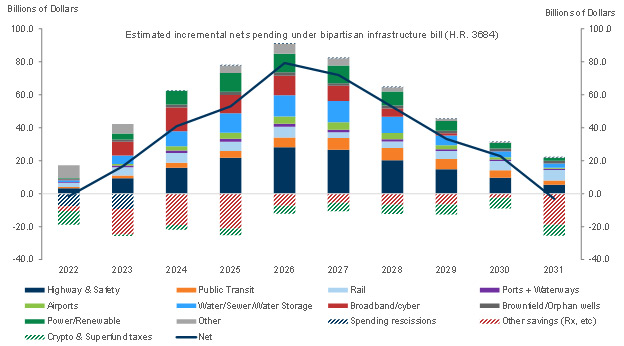By Sam Miller, CFA®, CFP®, CAIA®
Director of Research & Marketing
Despite a roller coaster year in Washington, President Biden’s fiscal agenda took two steps forward last week with the signing into law of the Infrastructure Investment and Jobs Act, and the House passing its version of the Build Back Better (BBB) legislation.
Slated to boost overall infrastructure funding by roughly $550 billion over the next ten years (Exhibit 1), the infrastructure bill will direct funding to the following categories:
- Transportation and Transit
- Clean Tech and Clean Energy
- Water Infrastructure and Environmental Remediation
- Digital Infrastructure and Resilience
Most of the funding will be earmarked towards traditional infrastructure items (including highways and public transit). Funding for climate-related issues, on the other hand, ended up being much more limited than originally hoped for by the administration. Regardless, this additional spending should translate into boosted revenues and a tailwind for those companies involved in traditional infrastructure development, as well as companies involved in Clean Tech, Cybersecurity, and other non-traditional infrastructure areas.
Exhibit 1: Key areas of spending in the infrastructure bill

Source: Congressional Budget Office, Goldman Sachs Global Investment Research.
Turning to the BBB plan, the House passed the $1.75 trillion bill on Friday, November 19th. Now the hard part begins, as the bill faces tough political realities in an evenly divided Senate. Several changes will likely be needed in order to secure the 50 votes required for passage. Major points of contention are likely to be paid leave, infrastructure and climate spending, and state and local taxes (SALT).
As we noted previously, the tax increases in the bill mainly apply to specific high-income individuals making over $400,000. Most of these changes would take effect for the 2022 tax year, except for the SALT provisions and the Section 1202 Stock exclusion which would be implemented retroactively for 2021. Currently, the bill’s key provisions include:
- Expansion of the Net Investment Income Tax (NIIT)
- Creation of a surtax
- Modified Adjusted Gross Income (MAGI) over $10 million would be subject to a new 5% surtax (with an additional 3% for MAGI over $25 million)
- Limitation of Section 1202 Stock Exclusion
- Extension of the expanded Child Tax Credit (for individuals earning less than $400,000)
- State and local taxes (SALT)
- As part of the Tax Cut and Jobs Act, SALT deductions were limited to $10,000. The current bill would allow taxpayers to deduct up to $80,000 from their federal taxes. The higher cap would remain in place through 2030, and then revert to $10,000.
- IRS Enforcement
- The bill would give the IRS an additional $80 billion in funding to hire more auditors and modernize technology. This likely increases the probability of audit for taxpayers earning more than $400,000.
Additionally, corporate tax reforms include:
- 15% Corporate Minimum Tax
- Increased Foreign Tax Rates
- Tax on Stock Buybacks
While Democratic Senate leaders have ambitious plans of passing the bill before year-end, they are also contending with the looming threat of a government shutdown. This pressure could either impede the bill’s progress or spur action—depending on how it’s addressed. Ultimately, once legislators return from the Thanksgiving holiday, there are only about ten legislative days left before year-end, so there’s a very limited window of opportunity.
We will continue to monitor the legislative process as we head towards year-end and communicate any further developments as they unfold. In the meantime, please reach out to your SEIA advisor if you have specific questions about how any of these developments and potential tax changes might impact your financial plan or portfolio.
The information contained herein is for informational purposes only and should not be considered investment advice or a recommendation to buy, hold, or sell any types of securities. The information contained herein was carefully compiled from sources SIA believes to be reliable, but we cannot warrant or guarantee the accuracy or completeness of the information provided. SIA is not responsible for the consequences of any decisions or actions taken as a result of the information provided herein. SIA is not engaged in rendering legal, accounting, or tax services. We recommend that all investors seek out the services of competent professionals in any of the aforementioned areas. For details on the professional designations displayed herein, including descriptions, minimum requirements, and ongoing education requirements, please visit www.signatureia.com/disclosures.
Signature Investment Advisors, LLC (SIA) is an SEC-registered investment adviser; however, such registration does not imply a certain level of skill or training and no inference to the contrary should be made. Securities offered through Royal Alliance Associates, Inc. member FINRA/SIPC. Investment advisory services offered through SIA. SIA is a subsidiary of SEIA, LLC, 2121 Avenue of the Stars, Suite 1600, Los Angeles, CA 90067, (310) 712-2323, and its investment advisory services are offered independent of Royal Alliance Associates, Inc. Royal Alliance Associates, Inc. is separately owned and other entities and/or marketing names, products or services referenced here are independent of Royal Alliance Associates, Inc.